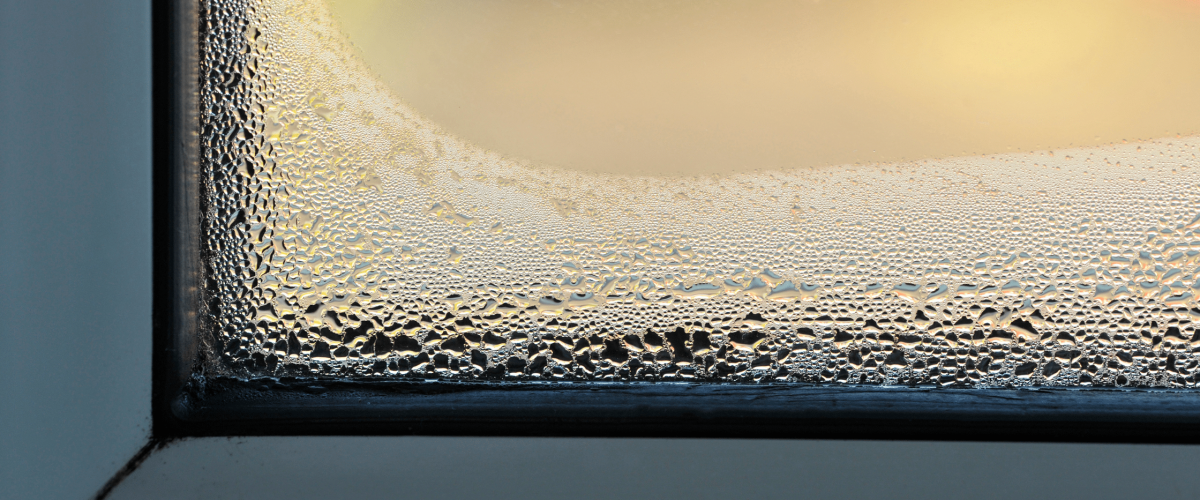Occasional, mild condensation is actually normal. But, when is it a problem, and what should you do? Excessive condensation can be a sign of too much humidity in your home, which is not good. Condensation on windows can be confused with seal failure. If you know what to watch for, you’ll be able to see what is normal and when to be concerned.
Let’s answer some of the most common questions about window seal failure and condensation on windows and the difference between the two.
What Is Window Seal Failure?
A window seal refers to the seal between the panes of glass. Double- and triple-pane windows can be manufactured with a gas between the panes. This boosts the windows’ energy efficiency by adding more insulation.
If a window experiences a seal failure, that means the inert gas leaks out from between the panes of glass at a slow pace, allowing moisture and air to seep into the insulated glass unit. The unit is compromised and can show visible moisture between the panes. However, this is not condensation.
Why Does a Window Seal Fail?
Manufacturing and installation issues are two of the biggest reasons why window seals fail. But even if your window’s been constructed and installed correctly, it’s prone to wear and tear. As the years pass, a seal may wear down or deteriorate to the point where you may have to repair or replace your window to fix this problem.
What are the Signs of Seal Failure?
Here are some of the most common signs of seal failure:
- Hazy Inside the Window: Fog, haze, mold, or liquid forms between your window’s glass layers.
- Distorted Window pane: When air leaks through a faulty seal, your window pane can bend or break.
How Can You Fix a Broken Window Seal?
Find out if your window installer or manufacturer offers a warranty. If they do, the installer may be able to repair or replace your defective window.
If you don’t have a warranty on your window, there are other options available.
For example, do-it-yourself defogging kits are available. These come with tools and instructions for how to fill a seal. However, these just remove the moisture from the inside of the window and don’t repair the energy-efficient benefits of a double- or triple-pane unit.
Instead of DIY kits, you also have the option to replace your window’s insulating glass unit (IGU), the sash, or the entire window.
Should You Fix a Faulty Window Seal on Your Own?
Using a DIY defogging kit or replacing your window’s IGU by yourself is rarely simple. If you make a mistake along the way, you could break or damage your window. Plus, DIY options don’t restore the energy-efficiency of the window.
When in doubt about how to fix a broken window seal, consult with a proven installer or window manufacturer.
If you’re dealing with a faulty seal, window professionals can offer replacement products that line up with your personal style and budget.
Or, if you’re only dealing with condensation in windows and the seals are still working properly, these professionals will have the answers you need..
What Is Window Condensation?
Condensation is the process of water vapor turning into a liquid. It forms on one side of a window if water collects on a cold surface after humid air has come into contact with it.
For example, condensation occurs when warm humid air comes in contact with a cold surface, which is usually the glass. At this point, window condensation may develop. This occurs because your window’s interior glass is cold and the sun’s rays are warm.
What Causes Condensation on Windows?
You may notice condensation on windows if there’s a significant temperature difference between two sides of their surface. In this situation, any of the following types of condensation may form:
- Exterior: This condensation forms on the outside of a window. It most often develops in the morning. By the middle of the day, the sunlight warms up and dries the surface. and the condensation disappears by the middle of the day.
- In-Between Window Panes: Those who have double- or triple-pane windows may see condensation between the panes. This usually indicates there’s issues with the seal.
- Interior: When there’s condensation on the interior of the home, that indicates that the indoor relative humidity is elevated. The U.S. Environmental Protection Agency (EPA) recommends keeping your home’s humidity level between 30-50 percent. If your house’s humidity level is higher than normal, it may be uncomfortable indoors and lead to fatigue, muscle cramps, and other health issues. On top of that, there’s a risk that mold and mildew will develop. The general rule of thumb is the colder it is outside, the lower your indoor relative humidity needs to be to reduce the chances for condensation on window surfaces.
What is Excessive Condensation?
Excessive condensation can be a real problem. If there is enough condensation to frost or fog to block a whole window, water can then run off the windows and stain woodwork or damage walls. The humidity (vapor) can also freeze the insulation in your home, which can later melt and damage your house. The humidity can also force its way out of a home through the siding, forming blisters under the exterior paint. Even worse, this moisture can collect in walls and ceilings — leading to rotting wood, insulation deterioration, mold and mildew, and even structural damage.
How Can You Get Rid of Condensation on Windows?
There are many simple and effective things you can do to get rid of condensation on windows, including:
- Use a dehumidifier. A dehumidifier helps remove water from the air.
- Run exhaust fans. Turn on the exhaust fan in your kitchen when you cook to help remove moisture from the air. Additionally, use your bathroom exhaust fan during or after a shower to help remove humid air from your home.
- Leave your interior doors open. If possible, keep your interior doors open to keep humid air from accumulating in one place.
- Run ceiling fans. This helps to circulate air in the room.
- Do not cover windows at night. This can trap cold behind the blinds or curtains, which blocks room air from circulating.
If you notice condensation between window panes or inside your window, partner with a window dealer. Professionals can come to your home and find out if you are dealing with defective windows. If these professionals believe now’s the right time to replace your windows, they can help you find the right ones for your home.
Don’t Let Window Condensation Get the Best of You
Window seal failure won’t fix itself. If this problem is causing condensation on your home’s windows, address it right away. Otherwise, high humidity levels can affect your health and well-being. They’ll also make it difficult to enjoy your time at home. For more information, read our Understanding Window Condensation guide.
At SoftLite Windows & Doors, our high-quality, energy-efficient windows are designed to meet the needs of homeowners. They are backed by best-in-class customer service, a transferable lifetime limited warranty, and more.
Contact a SoftLite Windows & Doors dealer for new replacement windows in your home.


 Single Hung
Single Hung
 Double Hung
Double Hung
 Casement
Casement
 Picture/Shapes
Picture/Shapes
 Sliding
Sliding
 Awning & Hopper
Awning & Hopper
 Bay & Bow
Bay & Bow
 Sliding Patio Doors
Sliding Patio Doors
 Entry Doors
Entry Doors


